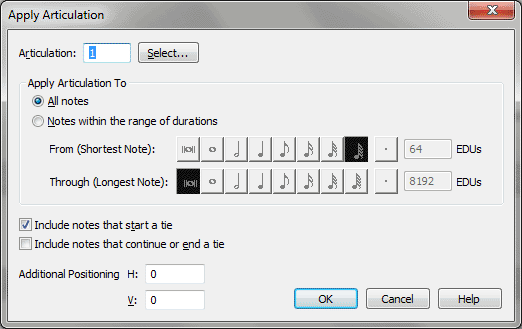Apply Articulation dialog box

How to get there
- Click the Selection tool
 , and select a region of measures (or part of a measure).
, and select a region of measures (or part of a measure).
- Choose Utilities > Apply Articulation. Or, click the Articulation
Tool and drag-enclose a series of notes.
What it does
The Apply Articulation dialog box lets
you apply an articulation mark (such as an accent or staccato mark) to
every note in a selected region. In fact, you can even apply a marking
only to every quarter note, for example.
- Articulation
• Select. The Articulation text box identifies, by number, the
articulation marking you’re about to place on the selected notes. (The
articulations in Finale’s articulation palette are numbered left to right,
top to bottom, starting from 1.)
Instead of typing in a number, it may be more
convenient to click Select. Finale displays a palette of all articulations
you’ve created (or loaded) in this document. Double-click the one you
want; you return to the Apply Articulation dialog box, where that marking’s
number appears in the text box.
- All
Notes. Leave this option selected if you want the selected articulation
to appear on every note or chord in the selected region.
- Notes
Within Range of Durations • From (Shortest Note) • Through (Longest note)
• EDUs. It doesn’t make much sense to put a staccato mark on a
whole note; nor is a fermata found very often on a 32nd note. For this
reason, you can specify what kinds of notes you want to receive the selected
articulation. In the From palette, click the smallest note value—and in
the Through palette, click the longest note value—you want to receive
the marking. All notes between (and including) those two note values will
be affected. (To specify a dotted rhythm, click the dot as well; click
the dot again to specify a non-dotted rhythm.)
If you only want quarter notes, eighth notes,
and sixteenth notes to have staccato marks, then, click the sixteenth
note in the From row, and the quarter note in the Through row. Finale
won’t apply staccato marks to whole notes, half notes, 32nd notes, for
example.
If the note-duration you’re looking for doesn’t
appear in the palette—for example, if you want to specify a quintuplet
quarter note—you can calculate its value and enter that number directly into one
of the EDUs boxes. There are 1024 EDUs per quarter note; you’d enter 1024
for a quarter note, 128 for a sixteenth, and so on.
- Include
Notes that Start a Tie. You usually wouldn’t expect to find a cesura
(full stop, or "railroad track") on a note that begins a tie;
the tie and the marking contradict each other. For cases like this, you
can deselect this checkbox, and Finale won’t apply the selected articulation
to any note that’s tied to a later note.
- Include
Notes that Continue or End a Tie. Similarly, you normally wouldn’t
expect to find an accent mark on a note that’s tied over from a previous
note. Select this checkbox if, for some reason, you do want Finale to
place the selected articulation on notes that are tied from a previous
note.
- Additional
Positioning: H: • V:. To specify a particular position for the
articulation you’ve selected (beyond any "smart" positioning
it’s been given using the Articulation Designer dialog box), enter numbers
into these boxes.
- OK
• Cancel. Click OK to return to the score, where Finale places
articulation markings according to your specifications—or click Cancel
to return to the score without changing anything.
See Also:
Articulations
Utilities
menu
Articulation
Tool

